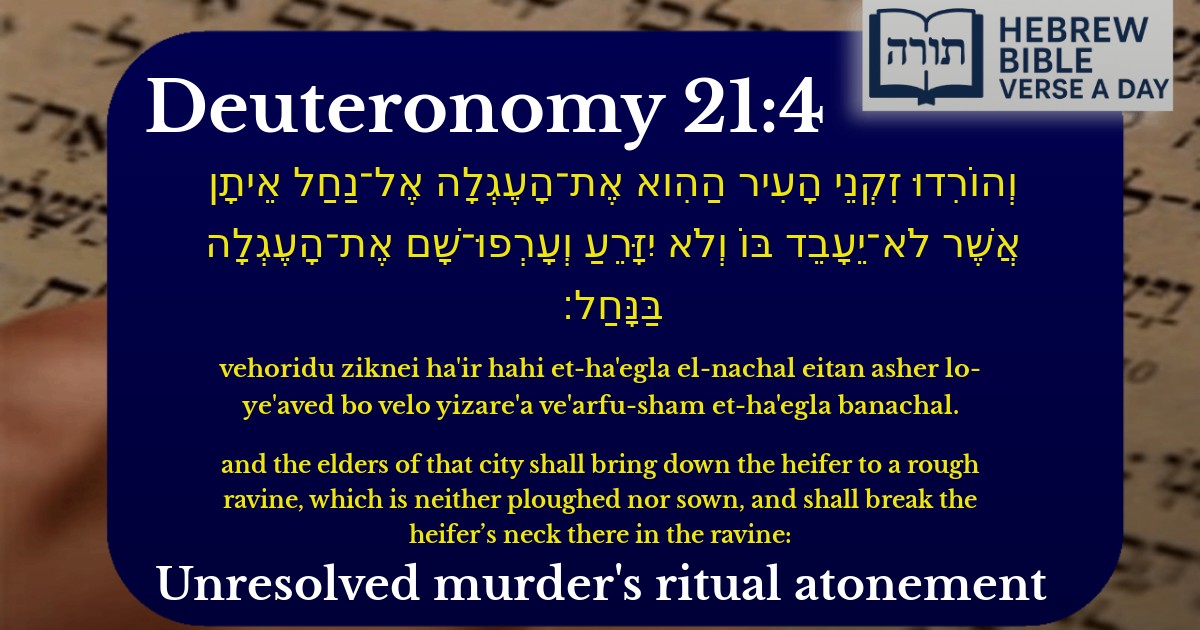Join Our Newsletter To Be Informed When New Videos Are Posted
Join the thousands of fellow Studends who rely on our videos to learn how to read the bible in Hebrew for free!
Hebrew Text
וְהוֹרִדוּ זִקְנֵי הָעִיר הַהִוא אֶת־הָעֶגְלָה אֶל־נַחַל אֵיתָן אֲשֶׁר לֹא־יֵעָבֵד בּוֹ וְלֹא יִזָּרֵעַ וְעָרְפוּ־שָׁם אֶת־הָעֶגְלָה בַּנָּחַל׃
English Translation
and the elders of that city shall bring down the heifer to a rough ravine, which is neither ploughed nor sown, and shall break the heifer’s neck there in the ravine:
Transliteration
Vehoridu ziknei ha'ir hahi et-ha'egla el-nachal eitan asher lo-ye'aved bo velo yizare'a ve'arfu-sham et-ha'egla banachal.
Hebrew Leining Text
וְהוֹרִ֡דוּ זִקְנֵי֩ הָעִ֨יר הַהִ֤וא אֶת־הָֽעֶגְלָה֙ אֶל־נַ֣חַל אֵיתָ֔ן אֲשֶׁ֛ר לֹא־יֵעָבֵ֥ד בּ֖וֹ וְלֹ֣א יִזָּרֵ֑עַ וְעָֽרְפוּ־שָׁ֥ם אֶת־הָעֶגְלָ֖ה בַּנָּֽחַל׃
Parasha Commentary
📚 Talmud Citations
This verse is quoted in the Talmud.
📖 Sotah 45b
The verse is discussed in the context of the ritual of the heifer whose neck is broken (eglah arufah), detailing the procedure and the significance of the location where it is performed.
📖 Sanhedrin 71a
The verse is referenced in a discussion about the laws pertaining to the heifer whose neck is broken, particularly focusing on the conditions of the ravine where the ritual takes place.


Context of the Verse
This verse (Devarim 21:4) describes the procedure of the עֶגְלָה עֲרוּפָה (eglah arufah), the ritual of the decapitated heifer, performed when a murdered body is found between cities and the killer is unknown. The elders of the nearest city must bring a heifer to an uncultivated valley and break its neck as an atonement for the unsolved crime.
Symbolism of the Unworked Valley
Rashi (Devarim 21:4) explains that the valley must be "אֵיתָן" (rough or enduring) and uncultivated to symbolize the tragedy of a life cut short before its time—just as this land remains unproductive. The Rambam (Hilchos Rotzeach 9:6) adds that the location must never be cultivated afterward, serving as a perpetual reminder of the unresolved murder.
Role of the Elders
The Talmud (Sotah 45b) emphasizes that the elders declare, "Our hands did not shed this blood" (Devarim 21:7), accepting communal responsibility. The Sifrei (Devarim 21:4) teaches that this ritual underscores the moral duty of leadership to ensure safe roads and justice. The breaking of the heifer's neck (rather than sacrificial slaughter) signifies that the act is not a korban but a solemn atonement.
Moral Lessons